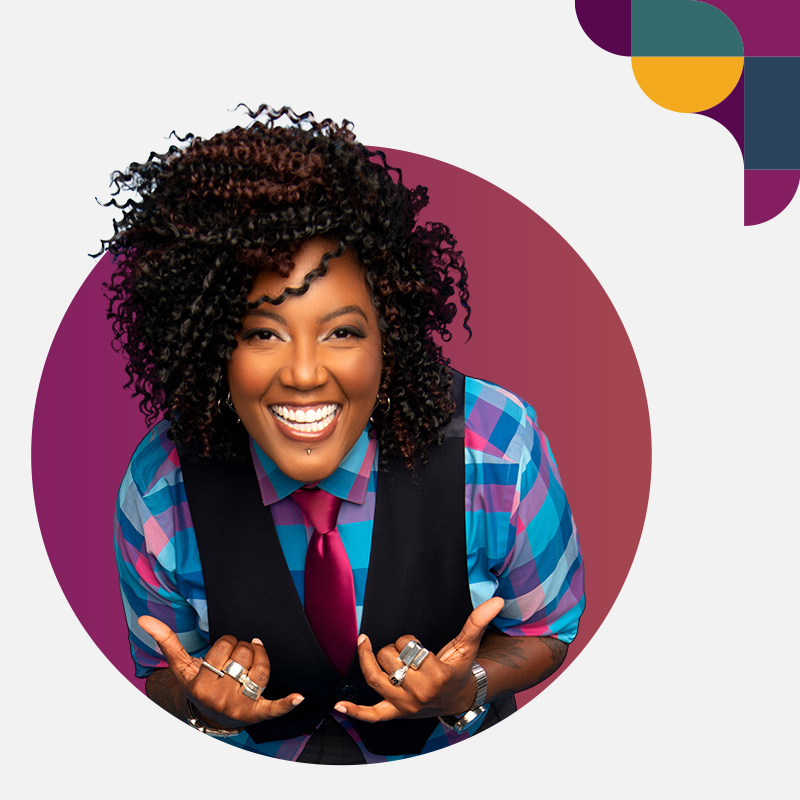- Why employee recognition should be a year-round priority
- Why one-off employee recognition activities can erode trust
- 10 Employee Recognition Day ideas to carry throughout the year
- Connect employees with company leaders
- Highlight actions that reflect company values
- Exchange personalized “thank you” cards
- Bring people together over food
- Host an awards ceremony
- Shine a light on employees’ great work
- Recognize employees on company social media channels
- Send tailored care packages
- Empower employees to treat themselves
- Encourage peer-to-peer recognition
- Integrating recognition into your company culture
- How Crakmedia elevates employees every day
- Extend recognition’s impact throughout the year
Employee Recognition Day, which occurs on the first Friday of March, shows appreciation for the invaluable contributions your employees make every day. But while many companies celebrate this annual event with catered lunches or gift baskets, these one-off gestures don’t convey how much each worker’s efforts are valued year-round.
Rather than thinking of Employee Recognition Day, also known as National Employee Appreciation Day, as a single special occasion, create a culture where employees feel recognized on an ongoing basis. Saying “thank you” for small acts, whether publicly or privately, helps individuals know their work has a meaningful impact. Regularly expressing gratitude builds trust and goodwill, improves engagement, and fuels long-term performance.
Find out how to thread Employee Recognition Day messaging throughout your culture to celebrate employees every day, not just once a year.
Why employee recognition should be a year-round priority
Employee recognition plays a crucial role in fostering employee engagement within an organization. When employees don’t feel adequately recognized, Gallup research reveals, they’re twice as likely to say they’ll quit in the coming year. But when employees feel recognized and appreciated, they’re more likely to be satisfied with their jobs and remain loyal to the organization.
It doesn’t take grand gestures to achieve these outcomes. In fact, experiencing small acts of recognition from business leaders, managers, and peers throughout the year often produces a more positive impact on morale than an extravagant event once per year.
“The type of recognition that we’re talking about here is one where people feel seen and appreciated,” says Betterworks Program Strategy Director Caitlin Collins. “That goes a very long way to really having a happiness quotient at work.”
When recognition becomes a regular practice, it becomes part of your organizational culture and helps people see the value in their own work. A culture of recognition increases employee engagement, as people feel more connected to organizational goals and values when their work is acknowledged.
“Over time, as you build that culture,” Caitlin says, “that’ll really resonate a lot in performance, productivity, engagement, and wellness. It’s a positive contributing factor.”
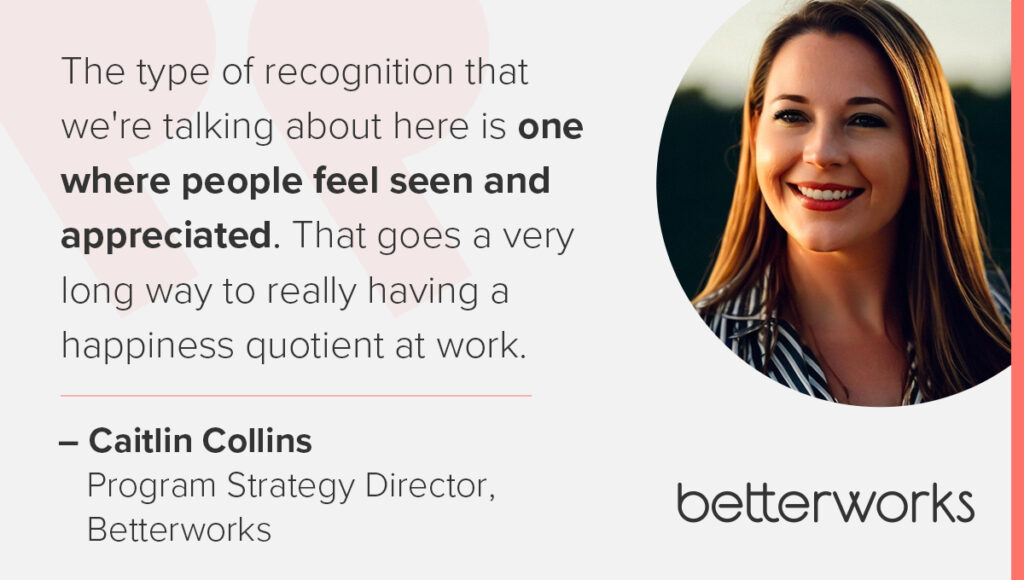
Why one-off employee recognition activities can erode trust
Employee recognition isn’t automatically positive. One-off activities can even erode trust, depending on how they’re handled. Here are a few common employee recognition mistakes, and how they might undermine your workplace culture.
Selective recognition
If you only recognize employees once a year, it’s hard to acknowledge each person individually. Often, the same few top performers receive the most public recognition from leadership, which can cause others to feel left out or that their work is less valued. This can create resentment within teams while signaling to employees that only certain types of employees are worth recognizing.
Performative recognition
Blanket recognition of every employee, however, can come across as equally insincere. Company-wide recognition of success that doesn’t mention specific achievements, contributions, or contributors can come off as performative.
Likewise, performative recognition can backfire if employees believe leaders are putting on a show or even stealing credit for other people’s work.
Insincere motives
One-off monetary or material rewards may be perceived as a superficial attempt to boost morale — and drive output — rather than sincere appreciation. That’s not to say that you shouldn’t offer material rewards on Employee Recognition Day or other occasions. But to carry real meaning, these kinds of offerings need to be structured within a larger strategy for recognition and total rewards.
Untailored recognition
Everyone likes to be recognized differently, but a generic, annual recognition event doesn’t give you the chance to personalize your appreciation. While many people do enjoy public praise, for example, others shy away or even find it embarrassing. By building the habit of ongoing recognition throughout the year, leaders can learn how employees want to be recognized and shape their Employee Appreciation Day ideas to meet those needs.
Infrequent attention
Infrequent, sporadic recognition leaves most of the year without acknowledgment and fails to develop trust through consistency over time. If not followed up on after the one-time event, employees may feel recognition was just for show rather than a priority, diminishing their trust in leadership’s sincerity.
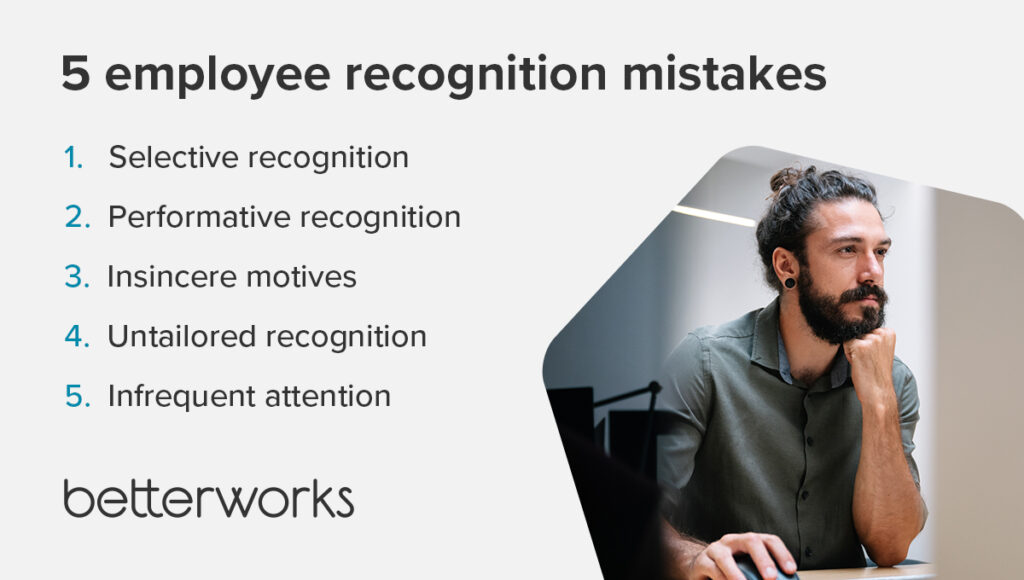
10 Employee Recognition Day ideas to carry throughout the year
Employee Recognition Day activities will be more meaningful and sincere when they’re part of a framework of frequent recognition. Layering in additional activities and rewards for special occasions can strengthen the bonds between employees, their managers, and the organization.
Here are some ways to celebrate Employee Appreciation Day as part of a year-round employee recognition program.
Connect employees with company leaders
In the weeks leading up to Employee Recognition Day, make time for the CEO or other executives to have one-on-one or small-group lunches (depending on the size of your organization). These meetings can occur virtually or in person. They give employees the chance to feel seen and appreciated by business leaders, who in turn get a better understanding of their workforce.
Highlight actions that reflect company values
Organize events that recognize employees’ contributions to company culture. Use these occasions to give awards or other recognition to individuals or teams who demonstrate exceptional commitment to company values. HR leaders can also use Employee Recognition Day to share stories about employees who exemplify organizational values, showcase their achievements, and inspire others to do the same.
Exchange personalized “thank you” cards
Encourage managers to write personalized notes to their team members that include specific actions or accomplishments they appreciate. Encourage employees to pay it forward with a stack of blank “thank you” cards they can send to colleagues. This encourages individual, personalized recognition that fosters a positive and supportive work environment.
Exchanging handwritten notes can be a powerful gesture for remote employees, too, although HR leaders and managers might need to coordinate this effort more carefully.
Bring people together over food
Cater a nice lunch for your staff so they can enjoy a meal together. During this lunch, you can encourage employees to share what they’re most proud of accomplishing during the past year. Alternatively, arrange for treats or snacks to be delivered to the break room. For remote employees, provide food delivery gift cards and encourage teams to share a virtual lunch together.
The small gesture of bonding over food can go a long way in showing appreciation and boosting employee morale.
Host an awards ceremony
Host an awards ceremony (virtually or in person) where employees are recognized for their outstanding performance, teamwork, and other notable achievements. Consider creating fun and unique awards that reflect the company’s culture and highlight individual team members’ strengths.
Shine a light on employees’ great work
Highlight a few team members each week leading up to Employee Recognition Day, highlighting their specific achievements or how they add to the culture. This helps managers to publicly recognize team members in a structured way. You can post these messages on your company’s intranet or messaging app, or share them via employee feedback software.
Recognize employees on company social media channels
Work with your company’s marketing team to publicly recognize and appreciate employees through your social media channels. Share achievements, milestones, and positive feedback from clients or colleagues.
Send tailored care packages
Send care packages to employees’ homes that promote relaxation, self-care, and well-being. These kits could include items like scented candles, stress-relief toys, healthy snacks, or personalized company merchandise.
Empower employees to treat themselves
Gift cards are a common employee gift, but you don’t need to give everyone the same freebie. Consider personalized gift cards that allow them to choose a gift of their preference from a pre-selected list. This shows appreciation while offering flexibility. Services like Sugarwish and Giftagram are just two of the options that allow customization for employee gifts.
Encourage peer-to-peer recognition
Recognition programs should include peer-to-peer acknowledgment, which can improve team dynamics, collaboration, and job satisfaction. Provide formal and informal opportunities for employees to give shout-outs, support each other, and live the company’s values.
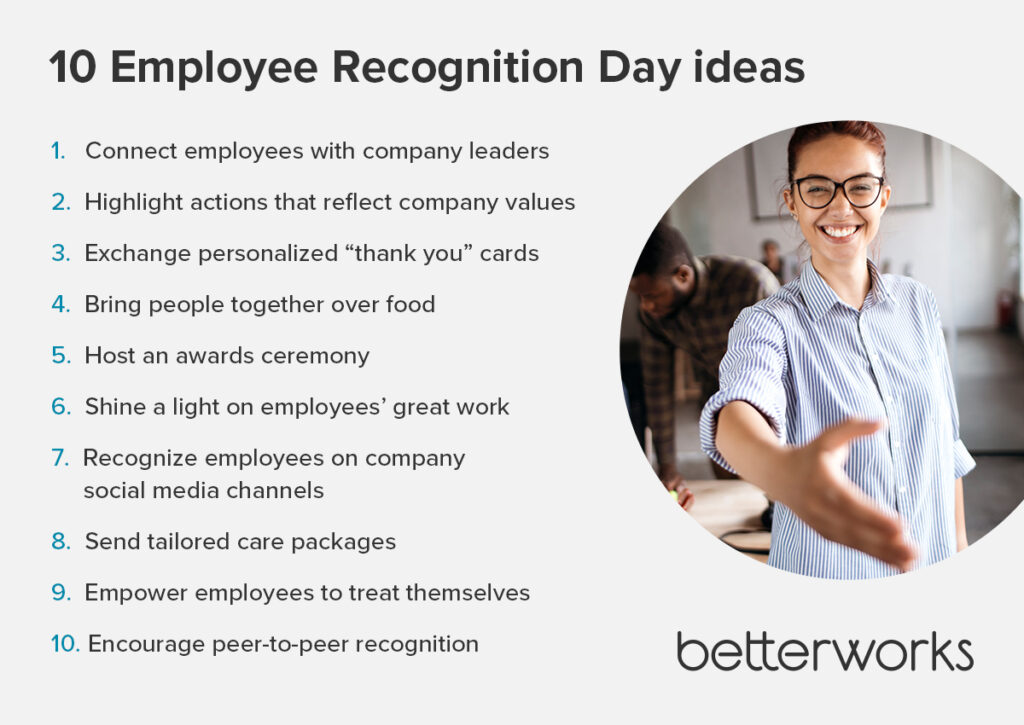
Integrating recognition into your company culture
Frequent and targeted recognition is key to a high-performing company culture where employees feel happy and aligned. To achieve those outcomes, you need to build recognition into your company’s daily processes. Here are a few steps to get started.
Establish a recognition program framework
Lean into employee engagement or company culture surveys to understand current recognition practices and identify opportunities for improvement. Make sure follow-up goals are specific. If managers aren’t currently checking in with employees regularly, for instance, set a goal to increase check-ins by a certain percentage.
Communicate recognition goals and expectations to managers. Focus on the “why” behind building a culture of employee recognition. “Tie how you recognize employees to the values that are most important to you as an organization,” says Betterworks Chief Operating Officer Andrea Lagan. “The easier you make it to do that, the more everyone in the company can walk the talk of the company values.”
Gather feedback from participants regularly and adjust the program over time. Track the company’s progress against your goals, and update them as needed.
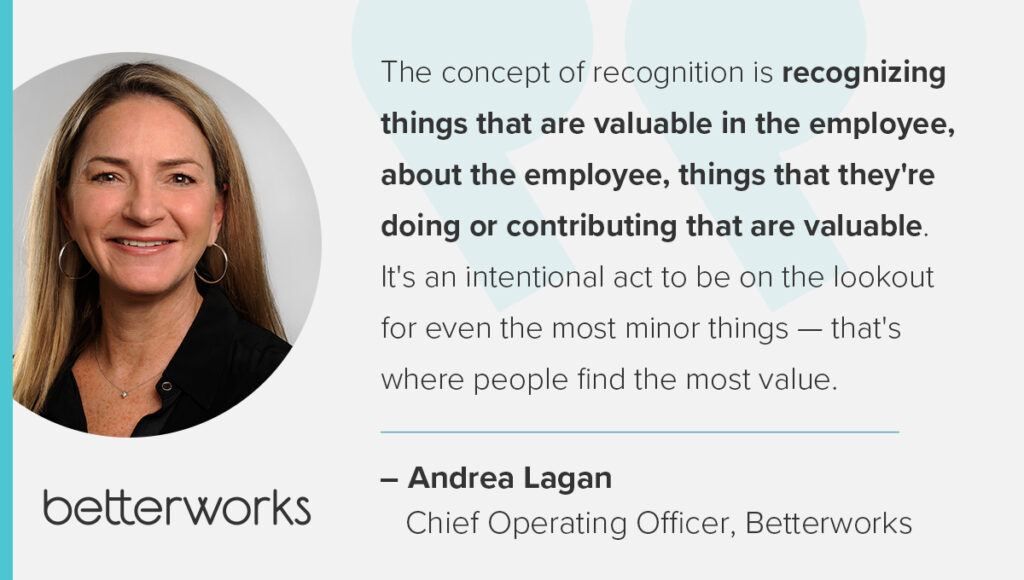
Train and empower managers
Managers are the primary drivers of a culture of recognition, so make sure they have the resources and support they need to bring such programs to life. Train managers to provide frequent, authentic recognition in one-on-one meetings. “It’s the lightweight conversations that you’re having with people regularly that are going to help build the muscle and make it a normal part of the operating rhythm,” Andrea says. Incorporate these recognition goals into manager performance reviews.
“Flowing this from the top down — and really investing the time and accountability into doing it — is a good place to start,” Caitlin says. “It’s all about reinforcement of the culture.”
Promote a culture of recognition
Make it easy for anyone to recognize others for all sorts of contributions, not just major achievements. “The concept of recognition is recognizing things that are valuable in the employee, about the employee, things that they’re doing or contributing that are valuable,” Andrea says. “It’s an intentional act to be on the lookout for even the most minor things — that’s where people find the most value.”
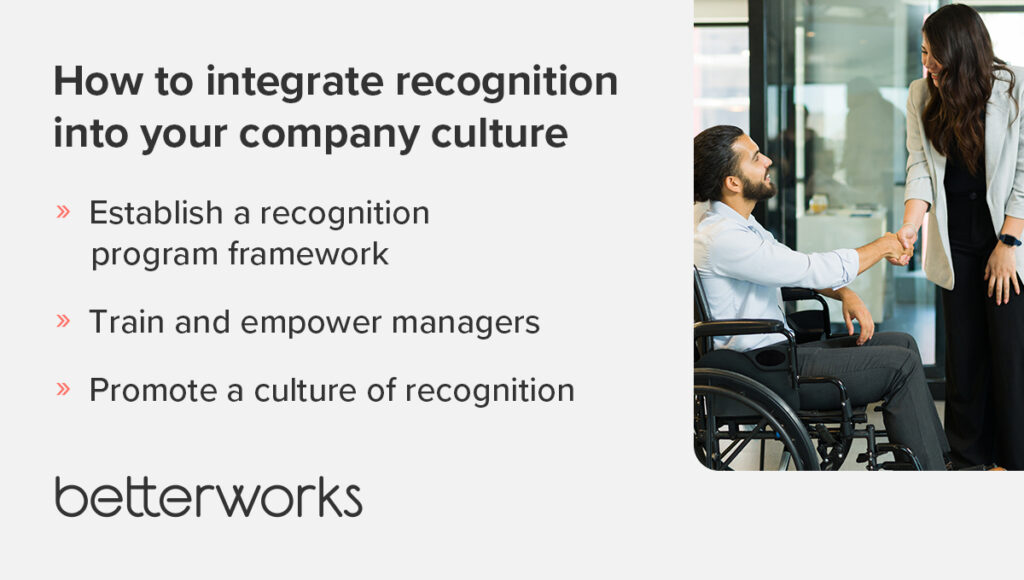
How Crakmedia elevates employees every day
With a focus on creating an employee-first culture, Crakmedia understands the importance of aligning goals and fostering continuous growth. By prioritizing employee satisfaction and growth, the company has created a vibrant and enjoyable workspace that fosters high performance and employee retention. Crakmedia leverages Betterworks’ intelligent performance management platform to streamline conversations, improve feedback loops, facilitate goal modifications, and promote continuous learning and growth.
That growth starts from day one, with a structured onboarding process that includes online and in-person training. Betterworks supports Crakmedia’s structured onboarding process by supporting manager-employee conversations and tracking progress. The platform enables regular check-ins, goal tracking, and progress reviews, making sure that employees are aligned with the company’s objectives.
Transparency and alignment are key components of Crakmedia’s employee recognition strategy. The Betterworks platform contributes to a collaborative atmosphere where employees can help each other achieve their goals. With seamless integrations with tools like Slack and Jira, Betterworks has become an integral part of Crakmedia’s workflow, making it easier to track and complete goals. The company also introduced “CrakAwards,” which emphasize and recognize employee alignment to the company’s core values.
Crakmedia’s implementation of Betterworks has contributed to a significant decrease in voluntary turnover, an increase in engagement scores, and a reduction in the time it takes for new hires to reach efficiency.
Extend recognition’s impact throughout the year
Employee Recognition Day events deliver more impact when you build a company culture that celebrates employees every day of the year.
The more your company can do throughout the year to recognize employee contributions, the more meaningful your Employee Recognition Day activities will be. Few things are better for employee engagement than showing your employees that you genuinely appreciate them.
Want to learn more? Discover the connection between employee recognition and retention.
Performance enablement fosters employee recognition







